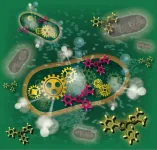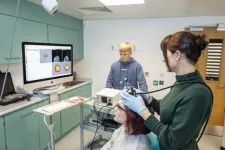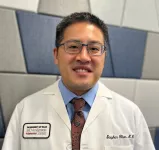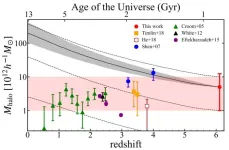(Press-News.org) How many relatives do Swedes have? And at what age is the family the largest? Researchers in demography at Stockholm University have found out in a new study.
Relatives often play an important role in people’s lives. Family members such as cousins, grandparents and grandchildren form part of an individual’s social network and can provide significant support, ranging from child-rearing to elderly care to financial assistance.
In a new study in the journal Demography, Martin Kolk and a group of researchers at Stockholm University have documented for the first time how many relatives Swedes have.
“There has been a lack of knowledge about how many kin people have in modern societies, and this information has never before been collected for an entire population. There have not been clear answers to questions such as how many cousins you have in Sweden or other countries,” says Martin Kolk, Associate Professor in Demography at Stockholm University’s Demography Unit and lead author of the study.
Sweden has unique registers
Research on family networks requires very large data sets that are of high quality and that go back far in history. The study uses Sweden’s unique population registers which enables researchers to create kinship networks where individuals can be linked to all of their living relatives.
How many relatives you have in life is affected by which part of the life cycle you are in. Older people have many relatives in the descending line, such as grandchildren, and younger people have relatives in the ascending line, such as parents, while people in the middle of life also have many relatives in the same generation, such as siblings and cousins. Swedes in the middle of their lives have an average of 8 cousins, and almost 30 percent have 11 or more cousins.
Of the types of relatives examined in the study (from grandchildren to grandparents), Swedes have an average of 20 relatives in their mid-30s, while young children have about 15 relatives, and 70-year-olds about 10.
“How many relatives you have is affected by many different things, such as differences in childbirth over time, when in life you have children, differences in life expectancy, and age differences between partners. All of these things can differ greatly between different families, and have also changed a lot over time,” says Martin Kolk.
Very rare with no relatives
Having no relatives at all in life is very rare, and only occurs in exceptional cases among very old people. The family networks of men and women are very similar. Over time, you see a higher proportion of relatives who are the result of separations, such as half-siblings.
“How many relatives you have differs very much between different individuals and at different ages. Most living relatives are found between ages 30 and 40. We see large variation in how many kin you have. The twentieth with the least kin have only 3–4 relatives, while the twentieth with the most kin have over 45.”
Relatives important for life chances
“By documenting kinship we know more about a previously unexplored part of Swedish family life that is an important part of many people’s lives. Social science research has also shown that relatives are more important for life chances in modern societies than previously thought, and therefore it is important to document how many kin people have.”
“Sweden has the longest records of any country with modern digitized population registers starting in 1968, with parent-child links from 1932. The state has been collecting national population back to 1749. This is both very useful for administrating the Swedish welfare state, and also make internationally unique research possible, such as this study,” says Martin Kolk.
Facts: How the study was done
The study is based on Swedish register data, and includes all Swedish-born people who lived in Sweden in 2018. With the help of birth records, the researchers have created family networks and calculated the number of relatives such as grandchildren, children, nieces, nephews, siblings, cousins, parents, parents’ siblings, and grandparents in Sweden through the unique Swedish national identity numbers. Using the register, the researchers have then calculated the averages and distributions of different categories of kin in Sweden. Since there is only demographic data within Sweden’s borders in Swedish register data, the study is focused on Swedish-born individuals. For individuals with foreign-born parents, grandparents are often missing. In the study, there are a number of figures showing the distribution and average number of kin of various types.
The article “The Swedish Kinship Universe: A Demographic Account of the Number of Children, Parents, Siblings, Grandchildren, Grandparents, Aunts/Uncles, Nieces/Nephews, and Cousins Using National Population Registers” is published in the scientific journal Demography. Authors are: Martin Kolk (Stockholm University), Linus Andersson (Stockholm University), Emma Pettersson (Karolinska Institutet) and Sven Drefahl (Stockholm University).
https://doi.org/10.1215/00703370-10955240
Contact
Martin Kolk, Associate Professor of Demography, Stockholm University’s Demography Unit, Department of Sociology.
E-mail: martin.kolk@sociology.su.se
Phone: 0046 76 239 79 46
END
Large variation in how many relatives Swedes have
2023-09-12
ELSE PRESS RELEASES FROM THIS DATE:
New insights to enhance treatment and diagnosis of blood cancer
2023-09-12
A ground-breaking study by researchers from the Cancer Science Institute of Singapore (CSI Singapore) at the National University of Singapore (NUS) has revealed crucial insights into the role of the histone methyltransferase NSD2 and its epigenetic target PKCα in causing t(4;14) translocated multiple myeloma (MM), a high-risk subtype of blood cancer, to be more aggressive and resistant to treatment.
The study was led by Professor Wee Joo Chng, Senior Principal Investigator at CSI Singapore, and Dr Phyllis Chong Shu Yun, Senior Research Fellow at CSI Singapore. The research team discovered that NSD2 triggers elevated glycolysis through the ...
Gotcha! New technology speeds up bacterial testing in food
2023-09-12
It is said that there is waste in haste, but researchers from Osaka Metropolitan University have proven that doing things rapidly does not necessarily mean working ineffectively. A research group led by Professor Hiroshi Shiigi at the Graduate School of Engineering, Osaka Metropolitan University has developed a technology that can rapidly and accurately determine the number of viable bacteria in food products electrochemically, using tetrazolium salt (MTT), a water-soluble molecule.
One of the most important assessment indicators for ensuring that food is free from contamination is the number of viable bacteria. However, conventional measurement methods take up to 2 days to yield results, ...
US teachers are less satisfied with their pay than most working adults
2023-09-12
Sixty-six percent of U.S. teachers who responded to a new, nationally representative RAND Corporation survey said their base salary was inadequate, compared with 39% of U.S. working adults. These teachers want a $17,000 increase in base pay, on average, to feel that their pay is adequate.
This equates roughly to a 27% pay increase, which is comparable to the estimated gap in pay between teachers and other similarly college-educated workers, also known as the “teacher pay penalty.”
In early 2023, RAND researchers surveyed public-school teachers about how salary and work hours affect ...
Targeted ultrasound can change brain functions for up to an hour after intervention
2023-09-12
The targeted use of ultrasound technology can bring about significant changes in brain function that could pave the way towards treatment of conditions such as depression, addiction, or anxiety, a new study suggests.
Research by neuroscientists at the University of Plymouth explored the impacts of an emerging technique called transcranial ultrasound stimulation (TUS).
Typically, ultrasound examinations involve diffuse broad beams of ultrasound being used to create images while leaving the target tissue unaffected.
However, focusing the beams through TUS can increase the pressure in the target region and change the way ...
U.S. advocacy strategy nets a 25 percent increase in lung cancer research funding
2023-09-12
[Singapore, 10:05 a.m. SGT--September 12, 2023] - A unified and concentrated lung cancer advocacy program in the United States resulted in a 25 percent increase in funding to a U.S.-based lung cancer research program, according to a presentation given today at the International Association for the Study of Lung Cancer 2023 World Conference on Lung Cancer in Singapore.
Lung cancer remains a major health concern, with mortality rates posing a significant challenge both globally and in the United States. The U.S. Department of Defense Congressionally Directed Medical Research Program/Lung Cancer Research Program (LCRP) was established in 2009 with a funding level of $20 million, but ...
IASLC staging model for mesothelioma validated; study supports continued use of model
2023-09-12
[Singapore, 10:05 a.m. SGT--September 12, 2023] – A model developed by the International Association for the Study of Lung Cancer in 2009 to help better stage mesothelioma cases performed well, according to an independent analysis presented today at The International Association for the Study of Lung Cancer (IASLC) 2023 Conference in Singapore.
Pleural mesothelioma is a rare but aggressive cancer primarily caused by asbestos exposure and presents complex challenges for effective staging and prognostication. The IASLC took a significant step in 2009 by establishing an international pleural mesothelioma database aimed at enhancing staging ...
Long-term outcomes of radiation techniques for locally advanced non-small cell lung cancer presented at IASLC 2023 Conference in Singapore
2023-09-12
[Singapore, 10:05 a.m. SGT--September 12, 2023] - Intensity-modulated radiation therapy, or IMRT, should be utilized for locally advanced NSCLC to reduce the risk of severe pulmonary toxicity and radiation exposure to the heart, according to research presented today at the International Association for the Study of Lung Cancer 2023 World Conference on Lung Cancer in Singapore.
Dr. Stephen Chun, MD Anderson in Houston, Texas, presented a comprehensive analysis of the phase III trial NRG Oncology-RTOG 0617, comparing intensity-modulated radiation therapy (IMRT) with 3D-conformal ...
Reproductive factors associated with higher risk of lung cancer in women
2023-09-12
[Singapore, 10:05 a.m. SGT--September 12, 2023] - A study presented at the International Association for the Study of Lung Cancer 2023 World Conference on Lung Cancer revealed that key reproductive factors such as early menopause, shortened reproductive span, and early age at first birth are associated with elevated risks of lung cancer in women.
Researchers from Xiangya Hospital, Changsha, Hunan, China, conducted a prospective cohort study involving 273,190 participants from the UK Biobank to delve into the links between individual reproductive ...
Dark matter halos measured around ancient quasars
2023-09-12
At the center of every galaxy is a supermassive black hole. Beyond a certain size, these become active, emitting huge amounts of radiation, and are then called quasars. It is thought these are activated by the presence of massive dark matter halos (DMH) surrounding the galaxy, directing matter towards the center, feeding the black hole. A team including researchers from the University of Tokyo have, for the first time, surveyed hundreds of ancient quasars and found this behavior is very consistent throughout history. This is surprising, as many large-scale processes show variation throughout the ...
Arf1 inhibitors promote the infiltration of cytotoxic T lymphocytes into tumors by affecting lipid metabolism
2023-09-12
In recent years, cancer immunotherapies, represented by immune checkpoint blockade (ICB), have been highly successful and have become an important basis for the future treatment of cancers. However, the absence of tumoral killer T cells and the complexity of tumor microenvironment can both affect the immunotherapeutic efficacy. Therefore, it is urgent to develop novel anti-tumor agents that can effectively promote effector T cell infiltration in tumors.
ADP-ribosylation factor 1 (Arf1) is a member of the Ras small GTPase family and is ...






